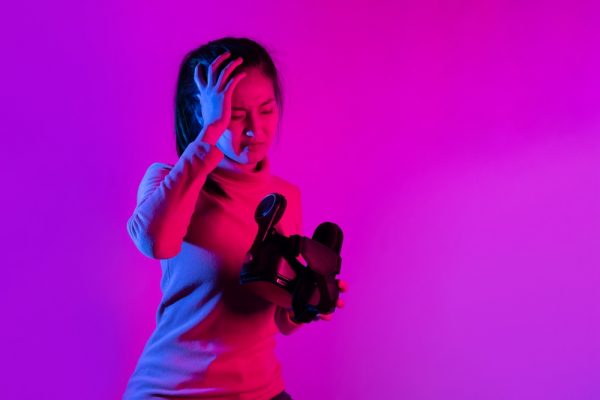If you’ve tried VR and found that it gave you motion sickness, even if you didn’t spend too long in the headset, you’re not alone.
Motion sickness is a problem that afflicts upwards of 70% of VR users, and what’s more, it only takes around 15 minutes before the symptoms start setting in.
The problem happens because your brain can’t square the difference between what your body is doing in real life and what your character is doing in VR.
You’re essentially sending two conflicting signals to your brain, and it’s struggling to deal with them, resulting in motion sickness.
Luckily, there are ways that you can alleviate or even outright avoid motion sickness in VR, although naturally, these solutions will differ from person to person in terms of efficacy.
Let’s take a look at some of the things you can do to avoid or ease motion sickness when playing games in VR!
Play a little at a time
The first way you can offset the effects of VR motion sickness is simply to limit the amount of time you spend playing.
Try playing VR games for ten to fifteen minutes at a time. The instant you feel any kind of sickness coming on, instantly stop playing and take a break.
When you feel OK again, return to your game and try playing another ten to fifteen minutes. If you can’t quite manage that long, then adjust the time depending on what you think you can cope with.
In time, you may find that you start to build a tolerance for VR gaming. It’s a similar phenomenon to sailing; some say that it takes time to get your “sea legs” on a boat, and the same is true of VR gaming.
Play games where you’re stationary

Many VR motion sickness problems arise when your character in the VR game is moving, but you’re standing still.
Some players reported that this was the case for Half-Life: Alyx, a VR shooter that offers both teleport-based movement and free walking.
When free walking is enabled, some players report that the disconnect between their stationary position in the real world and Alyx’s constant movement in the game world resulted in motion sickness.
With this in mind, one way to ease your VR motion sickness could be to play games in which your character remains stationary. Try some VR experiences that are more sedate before you “graduate” to the more complex VR titles.
Wear a pressure band
Whether or not pressure bands actually work for VR motion sickness is a matter of debate, but some users have reported that bands which put pressure on a certain point on the wrist can also help with VR motion sickness.
These bands are often sold to those who get bad motion sickness while travelling; they use the principles of acupuncture to put constant pressure on a certain area of your wrist, which apparently alleviates motion sickness.
Your mileage may vary on whether this works or not. For some, it seems to be an instant balm, while it doesn’t seem to work at all for others.
Unfortunately, the only way to know for sure is to test it out, so if you’re curious, look up a good-quality motion sickness wristband, strap it on while you’re playing, and see if that fixes your problem.
Only play when you’re feeling well
This should go without saying, but you shouldn’t engage with VR gaming if you’re already feeling a little under the weather, because it could exacerbate your symptoms.
If, for whatever reason, you’re already feeling a little queasy or nauseous, then spending time in a VR world isn’t going to help you and could just make the problem worse.
However, this doesn’t just go for when you’re feeling sick; it also applies when you have a headache or you’re experiencing some other health issue.
Stick to playing VR games when you’re feeling at the top of your game, and you’ll be able to better deal with any potential moments of queasiness you might experience.
Make sure your headset is adjusted properly

You might be experiencing VR motion sickness because the headset you’re wearing isn’t properly adjusted. This can lead to headaches and other health issues.
Make sure that you read the instruction manual that came with your VR headset thoroughly to find out how best to wear the headset, because if you get it wrong, it could mean more than just discomfort.
This is also important for ensuring that you’re getting the best experience possible out of your headset; if you’re not wearing it properly, then your viewing angle might be restricted, for instance, or the headset might fall off at an inopportune moment.
In short, read through the instructions carefully, make sure you know what you’re doing with your headset, and check that it’s properly adjusted and fitted before you start gaming.
Take something with ginger in it
Again, like the pressure band option, this may or may not work for you, but many users have reported that taking something that contains ginger helps with VR motion sickness.
This could, for instance, be a glass of ginger beer, or it could be eating a small piece of raw ginger. Supposedly, this helps to combat the effects of motion sickness when VR gaming.
Of course, if you don’t like ginger, this might not be a great option, but in that case, you could try taking ginger capsules, which often don’t have quite as strong a taste as raw ginger.
In any case, ginger can often be inexpensively acquired, so it’s a good idea to try it if you’re thinking of heading back into the VR vortex but you don’t want to feel ill while you’re there.

